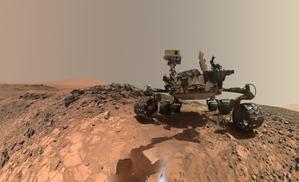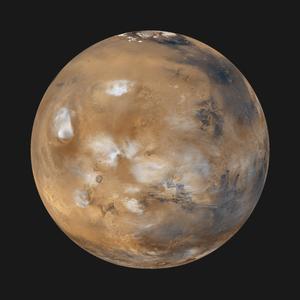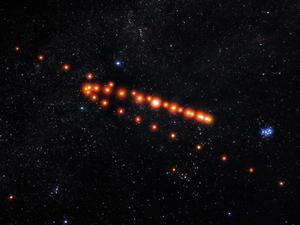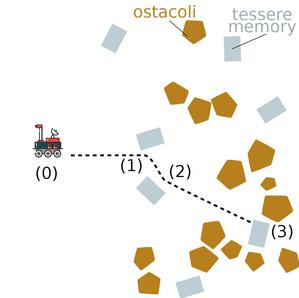Glossary term: Mars
Description: Mars is the fourth planet from the Sun in the Solar System. It is a rocky, terrestrial planet with a radius of a little under 3400 kilometers (km), just over one half of the Earth's radius. Mars has a very thin atmosphere, a large canyon system, and the tallest mountain in the Solar System: an extinct volcano called Olympus Mons. It is thought to have hosted liquid water earlier in its existence.
Its typical distance from the Sun is about 228 million km or 1.52 astronomical units (Earth–Sun distances). It takes 687 days to complete one orbit of the Sun. Mars has two small moons, Phobos and Deimos.
It is named after the Roman god of war. It is often called the "red planet" due to its reddish rusty color. Scientists have sent many landers to Mars over the years to study its composition and atmosphere.
Related Terms:
See this term in other languages
Term and definition status: This term and its definition have been approved by a research astronomer and a teacher
The OAE Multilingual Glossary is a project of the IAU Office of Astronomy for Education (OAE) in collaboration with the IAU Office of Astronomy Outreach (OAO). The terms and definitions were chosen, written and reviewed by a collective effort from the OAE, the OAE Centers and Nodes, the OAE National Astronomy Education Coordinators (NAECs) and other volunteers. You can find a full list of credits here. All glossary terms and their definitions are released under a Creative Commons CC BY-4.0 license and should be credited to "IAU OAE".
Related Media
Mars rover Curiosity
Credit: NASA/JPL-Caltech/MSSS credit link
License: PD Public Domain icons
Mars
Credit: NASA/JPL/MSSS credit link
License: PD Public Domain icons
Equatorial Milky Way
Credit: Giorgia Hofer/IAU OAE
License: CC-BY-4.0 Creative Commons Attribution 4.0 International (CC BY 4.0) icons
Retrograde Motion of Mars
Credit: Rob Kerby Guevarra/IAU OAE (CC BY 4.0)
License: CC-BY-4.0 Creative Commons Attribution 4.0 International (CC BY 4.0) icons
Related Activities
Children's Planetary Maps: Mars
astroEDU educational activity (links to astroEDU website) Description: Explore planet Mars, learning how to use planetary maps!License: CC-BY-4.0 Creative Commons Attribution 4.0 International (CC BY 4.0) icons
Tags: Maps , Planetary cartography Age Ranges: 6-8 , 8-10 , 10-12 , 12-14 Education Level: Middle School , Primary , Secondary Areas of Learning: Social Research Costs: Free Duration: 2 hours Group Size: Group Skills: Analysing and interpreting data , Asking questions , Constructing explanationsDriving on Mars
astroEDU educational activity (links to astroEDU website) Description: An educational interdisciplinary game to drive a rover on MarsLicense: CC-BY-4.0 Creative Commons Attribution 4.0 International (CC BY 4.0) icons
Tags: Game , robot , robotics , simulation , telecommunications Age Ranges: 14-16 , 16-19 Education Level: Middle School , Secondary Areas of Learning: Guided-discovery learning Costs: Low Cost Duration: 2 hours Group Size: Group Skills: Communicating information , Developing and using models , Using mathematics and computational thinking













